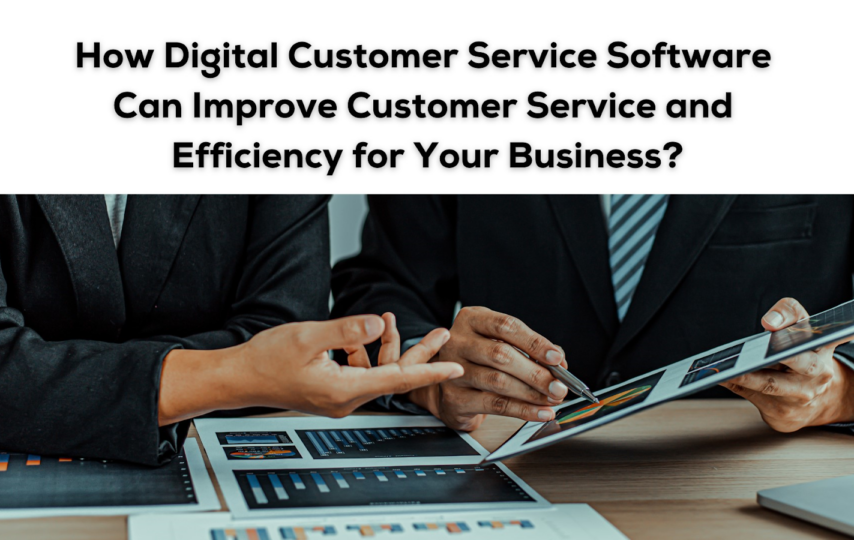In today’s rapidly evolving business world, utilizing digital customer service software is indeed essential. Based on the survey conducted by Statista, from June 2017 to July 2020, the world-wide average of customer communications, which are digital interactions, almost tripled, rising from just 20% to nearly 60%.
The pandemic accelerated the global adoption of digital solutions for customer interactions by three years. With such a significant shift towards digital interactions, it’s clear that businesses are recognizing the benefits of digital customer service software.
But what exactly are these benefits? Let’s explore how implementing digital platforms can provide immediate and long-term improvements for both the customer experience and business operations.
The Immediate Impact of Digital Customer Service Software
In today’s world, everything happens fast, and we want answers from companies too. That’s where digital customer service software comes in. It lets us talk to companies right away using chat, social media, and messaging apps. No more waiting for calls or emails.
But what’s cooler? Chatbots that use smart technology to talk to us 24/7. They’re like instant answer machines for simple questions. They can’t replace real people, but they’re super helpful. This means we don’t wait too long, and the real people have time for trickier stuff.
Personalization: Tailoring Customer Experiences
You know when you’re shopping online and it feels like the website knows exactly what you like? That’s thanks to digital customer service software. It uses cool math to learn about what you do, what you want, and what you bought before. With this info, companies can give you special suggestions and talk to you in a way that’s just for you.
But here’s the thing: even though tech is smart, it’s not as good as a real person who understands feelings. So, companies use smart tech and real people to ensure you’re happy. They use all the info they collect to help you find things you’ll love and send you messages that sound like they’re from a friend. So, it’s like getting help from a computer and a friendly human at the same time!
Efficiency and Productivity Gains
Did you know that digital customer service tools make things run smoother? They use cool tricks like giving tickets to the right people, having ready-made answers, and having talking robots. This means that people who help you can solve your problems quicker. They then have more time to work on bigger problems and make things better.
All this makes it much easier for the people who help you, so they can do more in less time. This kind of help can make companies spend way less money too. Experts found that using digital tools can make answering questions cost much less – around 60-70% less!
Integration with Other Business Systems
A major advantage of digital platforms is their ability to integrate seamlessly with existing CRM, sales, and marketing tools. This creates a centralized hub for managing all customer interactions across departments. Customer data flows freely between systems, providing agents with complete profiles and communication histories.
Ultimately, this omnichannel view of customers powers more consistent, contextual interactions. Whether customers reach out over phone, email, live chat, or social media, agents have the data to deliver informed, tailored responses.
Scalability: Adapting to Growing Customer Needs
Guess what? More and more people are talking to companies online instead of calling them. In North America, this went up from 25% to 65% in just a few years, says Statista. And this is only going to get bigger! But you know what’s cool? Digital systems made in a special way can handle lots of people, unlike the old ways.
Look at it like this: old systems need a big change to handle so many people. But digital platforms that live on the cloud are built to handle lots of growth right from the start. They can add more helpers, chat with more people at the same time, and use new ways to talk. So, even if a lot more people show up, these tools still work great.
For small businesses, this means that tools can grow as they do. And big companies can use these tools all over the world without a problem because these tools are always there, no matter where you are. That’s how tech makes sure everyone gets the help they need.
Measuring Success: Analytics and Reporting
Data-driven decision making is vital for continuous improvement in customer service. Digital software provides comprehensive reporting on metrics like ticket resolution rates, agent performance, query types, churn risk, customer satisfaction (CSAT) scores and more. Managers can track service levels in real-time to identify issues proactively.
These analytics uncover blind spots and opportunities that businesses may miss otherwise. For instance, they may reveal a sudden spike in complaints about a particular product. This allows corrective actions to be taken swiftly. Ongoing monitoring through actionable dashboards makes every improvement iterative.
Cost Efficiency
Talking about how good digital customer service sounds nice. But what about the money part? It turns out, it’s pretty awesome too.
Here’s how it works: the people helping us work better, and things cost less. Plus, customers like us more, so they stay with the company. And because digital stuff can handle lots of people, it’s like a money-saver even when more folks show up.
This all adds up to super good efficiency. But you know what? Older ways of talking to customers cost a lot when they need changes. So, switching to this cool digital way that lives online is smart and saves money in the long run.
The Future of Digital Customer Service
The software we use to talk to customers online is becoming super important, even more than just something we spend money on. People all over the world are using it more and more. But what’s next? How will these tools change in the future?
Predictive Analytics and Proactive Engagement
The numbers we get from analyzing past customer talks help us understand what happened before. But something exciting is coming up! We’re going to use those numbers to guess what might happen next.
Like, we can tell when people might ask certain things or when they might have problems. Imagine talking robots telling the helpers about customers who might leave, so we can talk to them first and keep them happy. It’s like we’re seeing the future to make things better!
The Evolving Role of AI
Artificial Intelligence (AI) is changing how we live and do things. AI is improving, from helpful assistants that answer our questions to smart programs that can spot diseases. In medicine, it’s helping doctors make good choices, and in school, it’s making learning special for each person.
But there are things to think about – like privacy and what’s right – as AI becomes a bigger part of our lives. As we look towards a future with more AI, it’s important to know how it’s changing and what it means for us.
In a world where tech is changing everything, AI is right in the middle. It’s changing how jobs work and how we talk to each other. Learning about how AI is changing can help us make smart choices for the future. We want to make sure that AI does what we want and helps us have better lives. Let’s learn about how AI is growing and what it might mean for our world.
Frequently Asked Questions
How secure is digital customer service software?
Data privacy and security should be critical evaluation criteria before adopting any customer service solution. Businesses must review all aspects from storage and backups to authentication mechanisms and encryption protocols for assurance.
Can digital customer service completely replace human agents?
While AI and automation are advancing rapidly, the human touch remains irreplaceable, especially for complex or sensitive customer issues. Chatbots can only handle common queries with preset responses. Personalized service and emotional intelligence still require human insight. Digital tools are best seen as enablers that allow agents to focus on delivering the human element in service.
How do businesses ensure quality remains consistent when transitioning to digital platforms?
Transitioning from legacy systems requires meticulous planning, extensive agent training, setting up digital channels in phases, gathering customer feedback to fix glitches, having in-built redundancies between tools, and gradually ramping up automation. With careful change management, businesses can switch to digital channels without drops in service quality or consistency. The long-term gains far outweigh the short-term switchover challenges.
Take Away
In today’s changing business world, using digital customer service software isn’t just a choice – it’s a must. The big increase in online interactions shows how important it is. By using these tools, businesses can make customers happier and work smoother, leading to success. It all starts with taking one step – bringing in digital solutions that push companies into a future where being great is normal.








